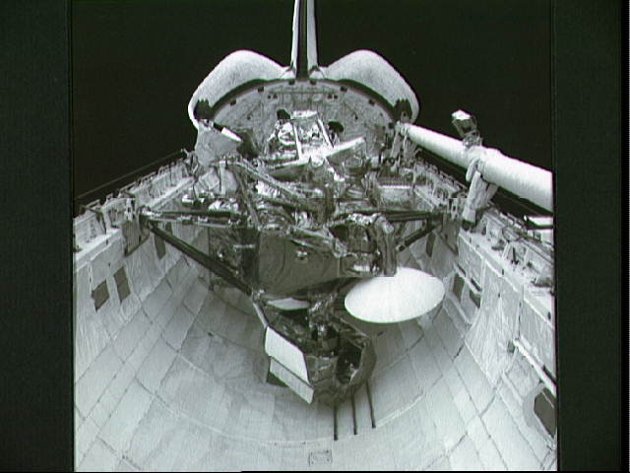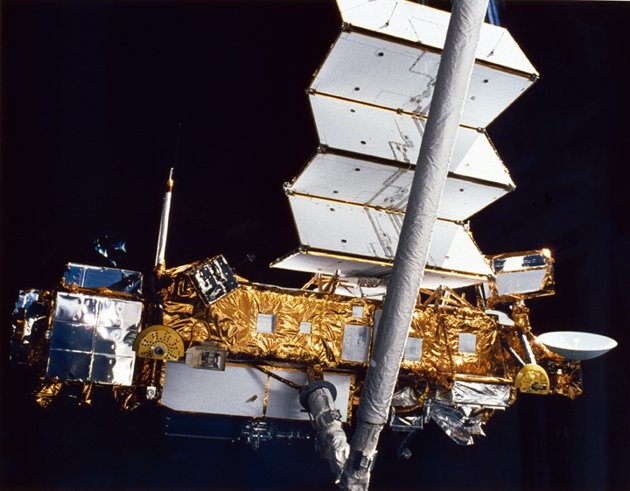The 20-year-old UARS (The Upper Atmosphere Research Satellite) research satellite is expected to break into more than 100 pieces as it enters the atmosphere, most of it burning up. Twenty-six of the heaviest metal parts are expected to reach Earth. (AP)

1. This screen grab image provided by NASA shows UARS attached to the robotic arm of the space shuttle Discovery during mission STS-48 in 1991, when UARS was deployed. NASA scientists are doing their best to tell us where a plummeting 6-ton satellite will fall later this week. It's just that if they're off a little bit, it could mean the difference between hitting Florida or New York. Or, say, Iran or India. (AP Photo/NASA)

2. The Upper Atmosphere Research Satellite (UARS) is deployed by the Space Shuttle Discovery (STS-48) in this NASA handout photo dated September 1991. The defunct (已死的,不存在的) NASA satellite is expected to fall back to Earth on Friday, showering debris somewhere on the planet although scientists cannot predict exactly where, officials said. UARS operated for 14 years, collecting measurements of ozone (臭氧) and other chemicals in the atmosphere. Since completing its mission in 2005, the satellite has been slowly losing altitude, tugged by Earth's gravity.

3. IN SPACE - UNDATED: In this handout from the National Aeronautics (航空学, 航空术) and Space Administration (NASA), the Upper Atmosphere Research Satellite (UARS) sits in the cargo bay of the Space Shuttle Discovery in September, 1991 in space. According to NASA, the 12,500 pound satellite will fall from orbit into earth's atmosphere anytime between September 22 through 24. It is estimated that the space craft will break up into about 100 pieces, with an estimated 26 of which could hit the earth over a possible 500 mile debris field. (Photo by NASA via Getty Images)
4. IN SPACE - SEPTEMBER 14: In this handout from the National Aeronautics and Space Administration (NASA), the Upper Atmosphere Research Satellite (UARS) is deployed from the Space Shuttle Discovery in September 14, 1991 in space. According to NASA, the 12,500 pound satellite will fall from orbit into earth's atmosphere anytime between September 22 through 24. It is estimated that the space craft will break up into about 100 pieces, with an estimated 26 of which could hit the earth over a possible 500 mile debris field. (Photo by NASA via Getty Images)
5. IN SPACE - SEPTEMBER 14: In this handout from the National Aeronautics and Space Administration (NASA), the Upper Atmosphere Research Satellite (UARS) is deployed from the Space Shuttle Discovery in September 14, 1991 in space. According to NASA, the 12,500 pound satellite will fall from orbit into earth's atmosphere anytime between September 22 through 24. It is estimated that the space craft will break up into about 100 pieces, with an estimated 26 of which could hit the earth over a possible 500 mile debris field. (Photo by NASA via Getty Images)
6. UNDATED: In this artist illustration handout from the National Aeronautics and Space Administration (NASA), the Upper Atmosphere Research Satellite (UARS) is seen. According to NASA, the 12,500 pound satellite will fall from orbit into earth's atmosphere anytime between September 22 through 24. It is estimated that the space craft will break up into about 100 pieces, with an estimated 26 of which could hit the earth over a possible 500 mile debris field. (Illustration by NASA via Getty Images)




